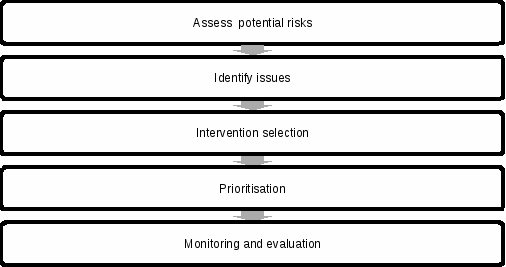
Road Safety Manual
A manual for practitioners and decision makers
on implementing safe system infrastructure!

Road Safety Manual
A manual for practitioners and decision makers
on implementing safe system infrastructure!
The Road Safety Management System provided information on the broader management of road safety, while Road Safety Targets, Investment Strategies Plans and Projects highlighted the need for effective road safety targets, policies and plans at the national and jurisdictional level. This chapter moves the focus to the importance of policies, standards, guidelines and tools relating to road safety infrastructure. The planning, design, operation and use of the road network will only produce effective results when interventions (including safe infrastructure programmes and projects) are implemented as part of an effective management system. An evidence-based approach is required that links institutional management functions to interventions, which in turn produce desired results. Details of this road safety management process are provided in The Road Safety Management System.
Information is provided on the development of policies, standards and guidelines, as well as tools to assist in delivering safe infrastructure. The introduction provides general principles of infrastructure safety management, drawing on material presented in earlier chapters (see especially The Road Safety Management System and Road Safety Targets, Investment Strategies Plans and Projects). It also sets a framework for later chapters by providing the overall approach to the assessment and treatment of road infrastructure for effective road safety outcomes. This approach involves the assessment of risk (identifying high risk locations discussed in detail in Assessing Potential Risks And Identifying Issues), identifying the issues contributing to these crashes (also in Assessing Potential Risks And Identifying Issues) identifying and selecting appropriate solutions (Intervention Selection And Prioritisation), prioritising action (also in Intervention Selection And Prioritisation) and monitoring, analysis and evaluation (Monitoring, Analysis and Evaluation of Road Safety). This overall process is graphically represented in Figure 9.1:

Start by assessing what infrastructure safety policies you have, and tools you already use, and assess whether these are the best for your situation. The information in this chapter will help identify required policies.
Train key staff to understand infrastructure safety management, and especially the principles provided under the Safe System approach (The Safe System Approach).
Collect and analyse crash data, as well as other intermediate data, starting with high risk routes (see Effective Management And Use Of Safety Data.
Start to develop tools to assess risks, initially through corridor and area demonstration projects utilising existing crash data as well as analysis of road deficiencies (see Management Tools).
Knowledge on effective interventions is required. Information on this issue is available in this manual (Intervention Selection And Prioritisation).
Staff need to be trained in the use of road safety infrastructure management tools.